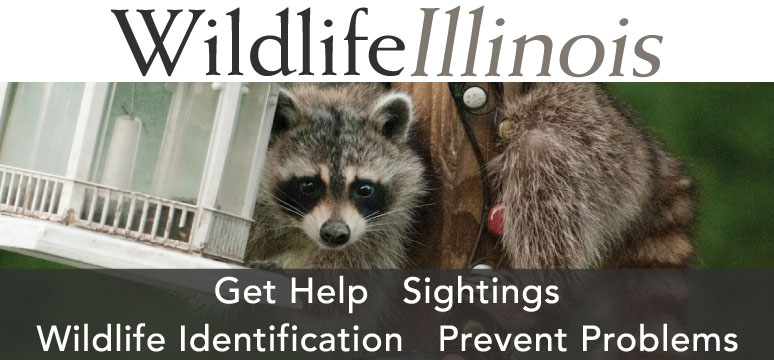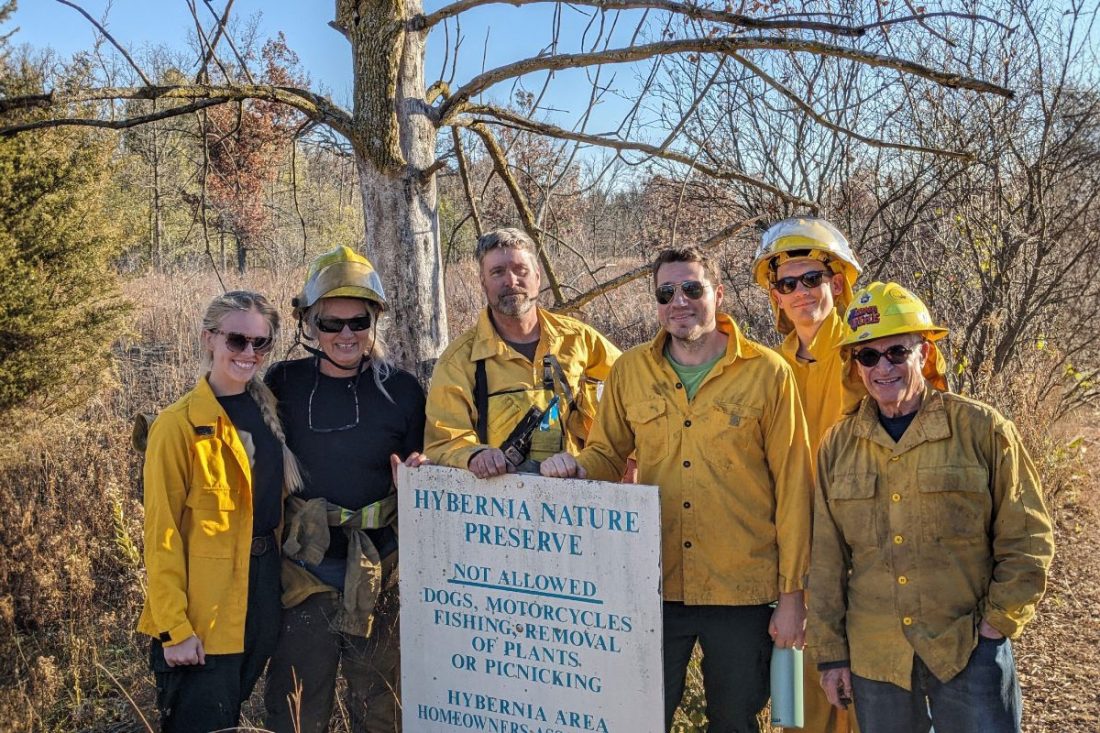
A happy burn crew at Hybernia Sedge Meadow (left to right): Claire Gregory, Cathy Pollack, John Nelson, Christos Economou, Stone Hansard and Marc Seidler. Not pictured is Bob Stanley. Photo by Bob Stanley.



A happy burn crew at Hybernia Sedge Meadow (left to right): Claire Gregory, Cathy Pollack, John Nelson, Christos Economou, Stone Hansard and Marc Seidler. Not pictured is Bob Stanley. Photo by Bob Stanley.
Illinois’ prairies, woodlands and wetlands evolved over millions of years with frequent fire. To stay healthy in today’s fragmented landscape, many of these ecosystems need more and better burning than they’re currently getting. It’s been estimated that only about 9 percent of the burnable acres statewide (and as little as 5 percent of habitat acres) burn each year. In the face of serious biodiversity loss, we need to be doing better.
In the past, much needed burning was done by expertly trained local volunteers, but these days, most is done by conservation staff and contractors. Reinvigorating volunteer involvement and initiative in burns is a potentially major part of getting the improved burning biodiversity needs. A few of my recent experiences point to some hows and whys.
Probably the biggest challenge is that fire needs outstrip capacity. There are only a limited number of days for effective burns each year so we want to maximize the impact of each one. But there are simply not enough crews to safely burn all sites that need it on appropriate days. This also means that fewer sites get burned on the best days, when the most ‘therapeutic’ burns for nature rehabilitation are possible. The bottom line is that burns that could happen don’t, and nature suffers.

Recognizing the challenges and the potential, Lake Forest Open Lands Association (LFOLA) teamed up with the Friends of Illinois Nature Preserves in 2021 to sponsor a new volunteer stewardship team dedicated to management of Skokie River Nature Preserve. This Illinois Nature Preserve is home to Shaw Prairie, one of the finest prairies in the state. Like that, the Shaw Prairie Stewards were born. Together, staff and volunteers set restoring and expanding the highest-quality parts of Shaw Prairie as a top priority. The plan calls for frequent burns, including a fall burn in 2023.
Due to recent personnel changes, staff at Lake Forest Open Lands were not sure they could burn Shaw Prairie safely by themselves in the fall of 2023. (This had occasionally been the case in previous years, too). But with the help of the Shaw Stewards, this was a non-issue. The Stewards had already been watching the weather days in advance. With just a few texts and emails, volunteers and staff had assembled a crew of 13 new and experienced burners to burn the prairie on Nov. 18, 2023. The same coordination in the spring of 2021 mustered a crew of 12, and in the spring of 2022, a crew of 8. Good planning and well-maintained fire breaks made this site easy to burn. All burns were safe and effective.
To recruit the crews, stewards reached out to fellow community members: friends, family and neighbors. Many people want to help and are eager to experience firsthand one of the most awesome forces of nature. Some crew members had formal training; others didn’t. But any fit and ‘on-the-ball’ person can do some of the needed jobs with brief training before the burn. Open Lands warmly welcomed the less-experienced folks and encouraged those with more experience to help coach them.
This is playing the long game. The mentorship and training everyone gets on the fire line is what will grow burn capacity in the years to come. It’s easy to imagine, sometime in the near future, splitting this crew of 12 into two experienced crews of six that could burn two different sites on the same day. This is what doubling capacity could look like.

“Our partnership with the Shaw Prairie Stewards has grown our operational capacity and resiliency,” Ryan London, President and CEO of LFOLA, had to say on working with the Shaw Prairie Stewards. “Organizations like LFOLA have benefited from fruits of the Friends’ relationships, which directly mirror the increased health and resiliency in the natural communities their volunteers are stewarding. The nimble and dependable group of Shaw Prairie Stewards has allowed us to navigate fewer ‘good burn’ days, staffing challenges while offering field experience for this critical tool in Illinois natural areas management.”
So far so good.
A similar story played out earlier that same week in 2023, just a few miles away at Hybernia Nature Preserve where a remnant sedge meadow and wet-mesic prairie were in sore need of a burn. On Sunday, Nov. 12, 2023, John Nelson (Illinois Nature Preserves Commission Preservation Specialist for northeast Illinois) checked the weather and the list of his sites that needed burning. Hybernia was toward the top of the list, and projected winds and humidity suggested Tuesday looked like a good day to do it.
Scientists have found that plant species diversity is inextricably linked with frequent fire in prairies. Some recommend burning them at least every three years to prevent species from dropping out, and probably more often than that to keep them truly healthy. Though understudied, the same probably applies for other grassland types, including sedge meadows, oak savannas and oak woodlands. But due to lack of a crew, Hybernia had not been burned in more than seven years. Rare plants there had been in decline as a result – presumably along with associated insects, fungi and myriad other biota.
Technically, primary responsibility for management of Illinois nature preserves lies with the landowner which, in this case, is the Hybernia Homeowners Association (HOA). Unsurprisingly though, Hybernia’s HOA has no trained ecology staff on the payroll. They rely on Nelson for expertise and initiative. But he is responsible for coordinating care of 140 other nature preserves across five counties. There’s not physically enough time for him to pay attention to the needs of each one. Even if Nelson oversaw a team of 10, they probably still could not provide the high-level care those 140 sites deserve. In this context, a robust network of trained volunteers will make a world of difference.

When it comes to burns, limited crew capacity affects all conservation agencies, but the Nature Preserve System feels it acutely due to years of budget cuts. Thanks to public support, Illinois Nature Preserves Commission staff is growing – but there are still only nine staff for a system containing more than 600 preserves. Burns at state-owned sites and nature preserves without the benefit of dedicated land managers are mostly done by state conservation staff, with occasional help from other nearby agencies or contractors as resources allow. This regularly required state staff to travel to each other’s sites, often from several counties away, to put together a sufficient team.
But if staff are off burning far away, they cannot burn their sites within their region and closer to home. This sometimes makes it difficult to justify burning smaller sites, since highly experienced burners are arguably more needed at (and more willing to travel for) larger and more technically complex burns. Fortunately, many nature preserve owners (especially Forest Preserve Districts) are making great strides to close the fire gap and lessen the burden on state nature preserve staff. To support and supplement this rising tide, we Friends have tried to do our part by training and empowering a volunteer network that could ultimately allow for burning ‘everything, everywhere, all at once.’ The long-term goal is that many expert local crews will one day exist across the state to take full advantage of every burn window, for nature’s sake.
John Nelson is one of the early adopters of this model. Thus, he knew that for a burn in the middle of the week, a couple days’ heads up would give people with day jobs some space to arrange time off. Sunday night he shot off an email to the Friends and a few local folks. By Tuesday, a crew of five volunteers and two staff was assembled, plenty to burn this small, but worthy, site. Again, Hybernia is an easy site to burn. Nestled in the middle of the Hybernia subdivision, the highest quality part is surrounded on one side by an asphalt road and on the other by a woodchip trail. It didn’t take long for the crew to safely burn the sedge meadow and adjacent prairie restoration. I was back at work just a few hours later.

The biggest challenge actually proved to be lining up all the permits and approvals needed.
Many people see catastrophic wildfires on TV and assume every fire threatens health and homes. Because of this, as well as legitimate concerns about air quality problems resulting from the burning of leaf piles, laws and regulations sometimes lump important ecological burns with such unnecessary fall traditions. This often means obtaining multiple local, state, and county permits, in addition to coordination with the local fire department and landowner, just to be able to burn.
Handling all this bureaucracy requires considerable time and effort from staff – time and effort taken away from providing real, on-the-ground care for nature. Meanwhile, some restrictions hamper the effectiveness of burns. There are even cases where local resistance to prescribed burning has led to the cessation of this critical work.
Governments and HOA boards are made up of ordinary citizens. Constituents of those officeholders are ordinary citizens. For long term survival of biodiversity, it’s crucial that policymakers and the general public understands why well-controlled burns are important and how safe they are for the communities around them. More than from anyone else, the best advocacy for changes needed in a community comes from members of that same community. Welcoming citizen-volunteers into the nitty gritty of biodiversity conservation, including prescribed burns, is an invaluable part of building awareness and constituency in the mission. It opens windows onto conservation needs and doors toward solutions no one might have foreseen.
This I know from experience: we volunteers are more than capable of rising to the challenge and thrilled to be part of something positive for the planet. As Illinois’ conservation community grows, I see a wonderful, fiery future on the horizon. It’s just better to burn with friends.
Christos Economou, professionally, is a PhD research chemist looking for novel medicines to treat human diseases. After years of anguished reading about the global decline of biodiversity, a few years ago he was lucky enough to fall in with the North Branch Restoration Project’s Somme Woods team – and felt empowered that he might be able to do something about it. Now working on his “second PhD,” he spends a lot of his free time studying tallgrass nature, seeking out treatments for ecosystem diseases as a Somme Woods zone steward, and supporting newer stewards with Friends of Illinois Nature Preserves.
Submit a question for the author